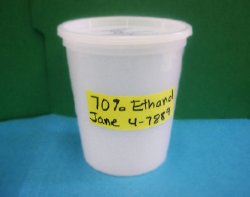Label containers clearly on the side, not the lid, with your name and phone number. Include the type of fixative on the container or the submission form, both to  ensure proper processing and to help us comply with waste disposal regulations. Indicate on the container(s) or submission form whether you want your container(s) returned.
ensure proper processing and to help us comply with waste disposal regulations. Indicate on the container(s) or submission form whether you want your container(s) returned.
Plastic snap-top containers such as the one shown are commonly used, inexpensive, and widely available from vendors of scientific supplies. However, the tops tend to loosen and leak with age, and they will pop open if dropped. Screw-top containers are better in these respects. Plastic scintillation vials are good for very small specimens.
Don't use conical-bottom centrifuge tubes, because tissues tend to sink to the bottom of the conical part, where the fixative doesn't reach them well. However, 50 ml screw cap tubes are OK for mouse spinal columns, as long as you don't put more than 2 or 3 in the same tube, and for mouse lungs, since they float.
Don't put tissues in narrow-mouth containers. Tissues harden and stiffen in fixative so that the container may have to be broken or cut open to retrieve the tissue.
Don't use glass, for obvious reasons.